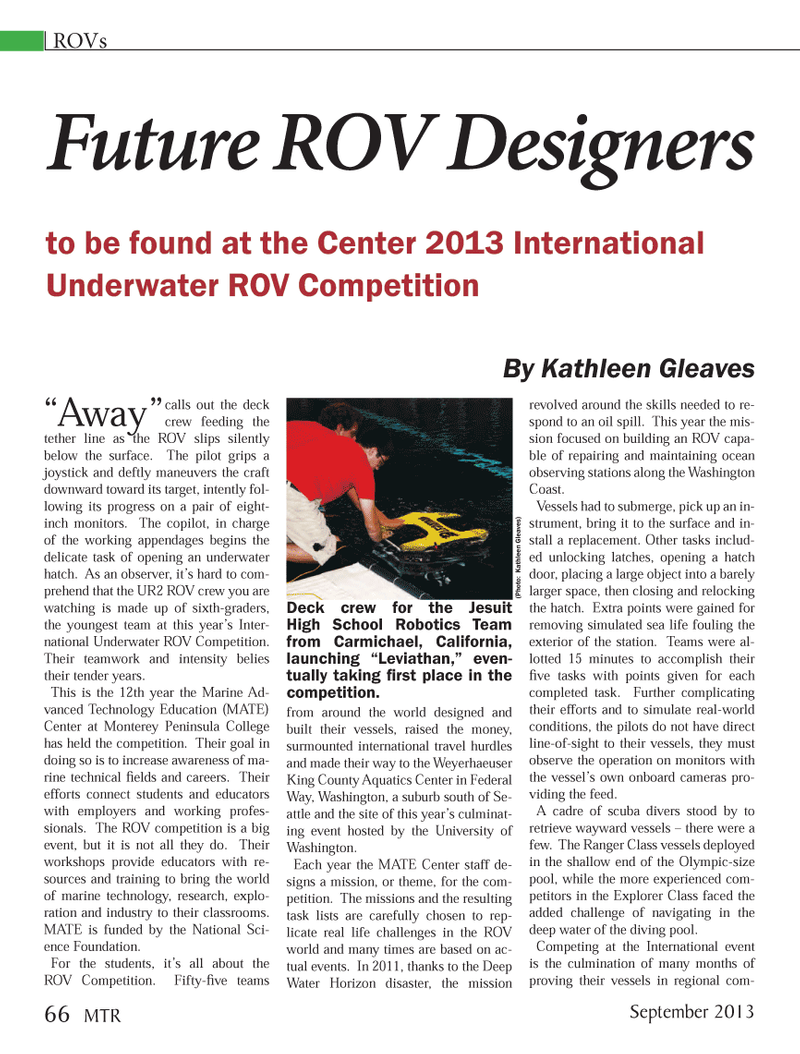
Page 66: of Marine Technology Magazine (September 2013)
Ocean Observation: Gliders, Buoys & Sub-Surface monitoring Networks
Read this page in Pdf, Flash or Html5 edition of September 2013 Marine Technology Magazine
?Away? calls out the deck crew feeding the tether line as the ROV slips silently below the surface. The pilot grips a joystick and deftly maneuvers the craft downward toward its target, intently fol- lowing its progress on a pair of eight- inch monitors. The copilot, in charge of the working appendages begins the delicate task of opening an underwater hatch. As an observer, it?s hard to com- prehend that the UR2 ROV crew you are watching is made up of sixth-graders, the youngest team at this year?s Inter- national Underwater ROV Competition. Their teamwork and intensity belies their tender years.This is the 12th year the Marine Ad- vanced Technology Education (MATE) Center at Monterey Peninsula College has held the competition. Their goal in doing so is to increase awareness of ma- rine technical elds and careers. Their efforts connect students and educators with employers and working profes- sionals. The ROV competition is a big event, but it is not all they do. Their workshops provide educators with re- sources and training to bring the world of marine technology, research, explo- ration and industry to their classrooms. MATE is funded by the National Sci- ence Foundation. For the students, it?s all about the ROV Competition. Fifty- ve teams from around the world designed and built their vessels, raised the money, surmounted international travel hurdles and made their way to the Weyerhaeuser King County Aquatics Center in Federal Way, Washington, a suburb south of Se- attle and the site of this year?s culminat- ing event hosted by the University of Washington. Each year the MATE Center staff de- signs a mission, or theme, for the com-petition. The missions and the resulting task lists are carefully chosen to rep-licate real life challenges in the ROV world and many times are based on ac- tual events. In 2011, thanks to the Deep Water Horizon disaster, the mission revolved around the skills needed to re- spond to an oil spill. This year the mis- sion focused on building an ROV capa- ble of repairing and maintaining ocean observing stations along the Washington Coast. Vessels had to submerge, pick up an in- strument, bring it to the surface and in- stall a replacement. Other tasks includ-ed unlocking latches, opening a hatch door, placing a large object into a barely larger space, then closing and relocking the hatch. Extra points were gained for removing simulated sea life fouling the exterior of the station. Teams were al- lotted 15 minutes to accomplish their ve tasks with points given for each completed task. Further complicating their efforts and to simulate real-world conditions, the pilots do not have direct line-of-sight to their vessels, they must observe the operation on monitors with the vessel?s own onboard cameras pro- viding the feed.A cadre of scuba divers stood by to retrieve wayward vessels ? there were a few. The Ranger Class vessels deployed in the shallow end of the Olympic-size pool, while the more experienced com- petitors in the Explorer Class faced the added challenge of navigating in the deep water of the diving pool. Competing at the International event is the culmination of many months of proving their vessels in regional com- ROVs Future ROV Designers Future ROV Designers to be found at the Center 2013 International to be found at the Center 2013 International Underwater ROV Competition Underwater ROV Competition By Kathleen Gleaves Deck crew for the Jesuit High School Robotics Team from Carmichael, California, launching ?Leviathan,? even- tually taking Þ rst place in the competition. (Photo: Kathleen Gleaves) September 201366 MTRMTR #7 (66-81).indd 66MTR #7 (66-81).indd 668/23/2013 9:06:51 AM8/23/2013 9:06:51 AM

 65
65

 67
67
